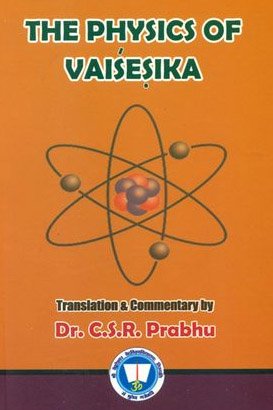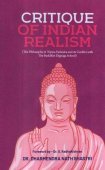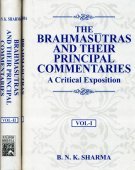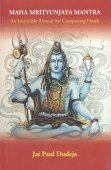Vaisheshika, Vaiseshika, Vaiśeṣika, Vaishesika: 19 definitions
Introduction:
Vaisheshika means something in Hinduism, Sanskrit, Jainism, Prakrit, Marathi, Hindi. If you want to know the exact meaning, history, etymology or English translation of this term then check out the descriptions on this page. Add your comment or reference to a book if you want to contribute to this summary article.
The Sanskrit term Vaiśeṣika can be transliterated into English as Vaisesika or Vaisheshika, using the IAST transliteration scheme (?).
Alternative spellings of this word include Vaisheshik.
In Hinduism
Natyashastra (theatrics and dramaturgy)
Source: archive.org: Natya ShastraVaiśeṣika (वैशेषिक).—One excelling (viśeṣayet) in all the arts (kalā) is called a Vaiśeṣika (specialist) or one is also called Vaiśika because of his dealings with the courtezans (veśyopacāra).

Natyashastra (नाट्यशास्त्र, nāṭyaśāstra) refers to both the ancient Indian tradition (shastra) of performing arts, (natya—theatrics, drama, dance, music), as well as the name of a Sanskrit work dealing with these subjects. It also teaches the rules for composing Dramatic plays (nataka), construction and performance of Theater, and Poetic works (kavya).
Vaisheshika (school of philosophy)
Source: Shodhganga: A study of Nyāya-vaiśeṣika categories (vaisesika)Vaiśeṣika (वैशेषिक) system advocates Dualistic Realism. It is said that this system has been founded on a Ṛk ascribed to the Seer Dīrghatamas. The Ṛk narrates that two birds which are intimate friends, reside in the same tree. One of them eats the sweet fruits, while the other without eating just looks on. The dualistic philosophers are influenced by this Ṛk which implies the distinction between the individual self and the Supreme self.
The founder of Vaiśeṣika is Kaṇāda. The name of this system Vaiśeṣika is derived from the word Viśeṣa. Viśeṣa as a separate category is discussed broadly in this system.52 We do not find this category in any other system of Indian Philosophy. So, Kaṇāda’s philosophy has come to be known as Vaiśeṣika system. The Vaiśeṣika system gives stress on the plurality and distinctness of physical things and finite souls. The special feature of this system is the theory of atomism.

Vaisheshika (वैशेषिक, vaiśeṣika) refers to a school of orthodox Hindu philosophy (astika), drawing its subject-matter from the Upanishads. Vaisheshika deals with subjects such as logic, epistemology, philosophy and expounds concepts similar to Buddhism in nature
Vaishnavism (Vaishava dharma)
Source: Pure Bhakti: Brhad BhagavatamrtamVaiśeṣika (वैशेषिक) refers to:—A later division of the nyāya school of philosophy, also known as vaiśeṣika-darśana. It was founded by Kaṇāda Ṛṣi. (cf. Glossary page from Śrī Bṛhad-bhāgavatāmṛta).

Vaishnava (वैष्णव, vaiṣṇava) or vaishnavism (vaiṣṇavism) represents a tradition of Hinduism worshipping Vishnu as the supreme Lord. Similar to the Shaktism and Shaivism traditions, Vaishnavism also developed as an individual movement, famous for its exposition of the dashavatara (‘ten avatars of Vishnu’).
Ayurveda (science of life)
Source: gurumukhi.ru: Ayurveda glossary of termsVaiśeṣika (वैशेषिक):—[vaiśeṣikaḥ] One of the orthodox indian philosophy postulated by Acharya kanada and famous for molecular theory

Āyurveda (आयुर्वेद, ayurveda) is a branch of Indian science dealing with medicine, herbalism, taxology, anatomy, surgery, alchemy and related topics. Traditional practice of Āyurveda in ancient India dates back to at least the first millenium BC. Literature is commonly written in Sanskrit using various poetic metres.
General definition (in Hinduism)
Source: Digital Library of India: Nyāya-Vaiśeṣika
Vaiśeṣika (वैशेषिक) is one of the six Hindu schools of philosophy (Vedic systems) of India. Historically, it has been closely associated with the Hindu school of logic, Nyaya. Although the Vaisheshika system developed independently from the Nyaya, the two eventually merged because of their closely related metaphysical theories.
Vaisheshika espouses a form of atomism and postulates that all objects in the physical universe are reducible to a finite number of atoms. Originally proposed by the sage Kaṇāda (or Kana-bhuk, literally, atom-eater) around the 2nd century BC.
According to the Vaisheshika school, all things which exist, which can be cognised, and which can be named are padārthas (literal meaning: the meaning of a word), the objects of experience. All objects of experience can be classified into six categories,
- dravya (substance),
- guṇa (quality),
- karma (activity),
- sāmānya (generality),
- viśeṣa (particularity)
- and samavāya (inherence).
In Jainism
Jain philosophy
Source: archive.org: Anekanta Jaya Pataka of Haribhadra SuriVaiśeṣikā (वैशेषिका) refers to a “follower of the Vaiśeṣika system of philosophy”, as occurring in the Anekāntajayapatākā-prakaraṇa, a Śvetāmbara Jain philosophical work written by Haribhadra Sūri.—[Cf. Vol. I, P. 67, l 25]—Vaiśeṣikā (lit. “the investigator of distinctive properties”) is the name of the follower of the Vaiśeṣika system of philosophy. It is founded by Kaṇāda known as Kaṇabhakṣa, Kaṇabhuj, Kāṇāda, Ulūka and Aulukya. Pāśupata is another name for a Vaiśeṣika.
-
Languages of India and abroad
Marathi-English dictionary
Source: DDSA: The Molesworth Marathi and English Dictionaryvaiśēṣika (वैशेषिक).—m S A follower of the school of philosophy called vaiśēṣika.
Marathi is an Indo-European language having over 70 million native speakers people in (predominantly) Maharashtra India. Marathi, like many other Indo-Aryan languages, evolved from early forms of Prakrit, which itself is a subset of Sanskrit, one of the most ancient languages of the world.
Sanskrit dictionary
Source: DDSA: The practical Sanskrit-English dictionaryVaiśeṣika (वैशेषिक).—a. (-kī f.)
1) Characteristic, special; विषये वर्तमानानां यं तं वैशेषिकैर्गुणैः (viṣaye vartamānānāṃ yaṃ taṃ vaiśeṣikairguṇaiḥ) (prāhurviṣayagoptāram) Mahābhārata (Bombay) 12.47.7; 7.5.15.
2) Belonging to the Vaiśeṣika doctrine.
-kaḥ A follower of the Vaiśeṣika doctrine.
-kam [viśeṣaṃ padārtha- bhedamadhikṛtya kṛto granthaḥ ṭhañ] One of the six principal Darśanas or systems of Hindu philosophy founded by Kaṇāda; it differs from the Nyāya philosophy of Gautama in that it recognizes only seven instead of sixteen categories or heads of predicables (the earlier writers e. g. Kaṇāda recognizing only six), and lays particular stress upon Viśeṣa.
Source: Cologne Digital Sanskrit Dictionaries: Shabda-Sagara Sanskrit-English DictionaryVaiśeṣika (वैशेषिक).—m.
(-kaḥ) A follower of the Vaiśeshika doctrine. n.
(-kaṃ) The Vaiśeshika doctrine, or branch of the Nyaya or logical school of philosophy, instituted by Kanada. It differs from Gautama'S system in recognizing only seven categories instead of sixteen. E. viśeṣa difference, (from the original Nyaya of Gautama,) ṭhañ aff.
Source: Cologne Digital Sanskrit Dictionaries: Benfey Sanskrit-English DictionaryVaiśeṣika (वैशेषिक).—i. e. viśeṣa + ika, I. adj. 1. Characteristic, Bhāṣāp. 43. 2. Belonging to the Vaiśeṣika doctrine (cf. Ii.), Bhāṣāp. 104; 140. Ii. n. A peculiar philosophical system, the Vaiśeṣika doctrine. Iii. m. A follower of the Vaiśeṣika doctrine, [Kusumāñjali, (ed. Cowell.)] 3, 8 (p. 29, 13, ed. Cowell).
Source: Cologne Digital Sanskrit Dictionaries: Cappeller Sanskrit-English DictionaryVaiśeṣika (वैशेषिक).—[feminine] ī particular, specific, extraordinary. [masculine] a follower of the Vaiśeṣika doctrine; [neuter] peculiarity, characteristic, [Name] of a philos, system.
Source: Cologne Digital Sanskrit Dictionaries: Monier-Williams Sanskrit-English Dictionary1) Vaiśeṣika (वैशेषिक):—mf(ī)n. ([from] vi-śeṣa, p.990) special, peculiar, specific, characteristic, [Āpastamba; Suśruta; Bhāṣāpariccheda; Hemādri’s Caturvarga-cintāmaṇi]
2) distinguished, excellent, pre-eminent, [Mahābhārata]
3) relating or belonging to or based on or dealing with the Vaiśeṣika doctrine, [Bhāṣāpariccheda; Madhusūdana]
4) m. a follower of the V° doctrine, [Kapila; Kusumāñjali; Buddhist literature]
5) n. peculiarity, distinction, [Kaṇāda’s Vaiśeṣika-sūtra]
6) Name of the later of the two great divisions of the Nyāya school of philosophy (it was founded by Kaṇāda, and differs from the, ‘Nyāya proper’ founded by Gautama, in propounding only seven categories or topics instead of sixteen; and more especially in its doctrine of viśeṣa, or eternally distinct nature of the nine substances, air, fire, water, earth, mind, ether, time, space, and soul, of which the first five, including mind, are held to be atomic), [Indian Wisdom, by Sir M. Monier-Williams 65 etc.]
Source: Cologne Digital Sanskrit Dictionaries: Yates Sanskrit-English DictionaryVaiśeṣika (वैशेषिक):—(kaḥ) 1. m. A follower of the Vaisheshika doctrine. a. That doctrine, or branch of the Nyāya school.
Source: DDSA: Paia-sadda-mahannavo; a comprehensive Prakrit Hindi dictionary (S)Vaiśeṣika (वैशेषिक) in the Sanskrit language is related to the Prakrit word: Vaisesia.
[Sanskrit to German]
Sanskrit, also spelled संस्कृतम् (saṃskṛtam), is an ancient language of India commonly seen as the grandmother of the Indo-European language family (even English!). Closely allied with Prakrit and Pali, Sanskrit is more exhaustive in both grammar and terms and has the most extensive collection of literature in the world, greatly surpassing its sister-languages Greek and Latin.
Hindi dictionary
Source: DDSA: A practical Hindi-English dictionaryVaiśeṣika (वैशेषिक) [Also spelled vaisheshik]:—(nm) one of the six major systems of Indian philosophy.
...
Kannada-English dictionary
Source: Alar: Kannada-English corpusVaiśēṣika (ವೈಶೇಷಿಕ):—
1) [adjective] of a distinct or particular kind or character; special.
2) [adjective] relating or belonging to or based on or dealing with the ವೈಶೇಷಿಕ [vaisheshika] doctrine (see ವೈಶೇಷಿಕ [vaisheshika]2 below).
--- OR ---
Vaiśēṣika (ವೈಶೇಷಿಕ):—
1) [noun] that which is of a distinct or particular kind or character; a special thing.
2) [noun] one of the six classical system of Indin philosophy, founded by the sage Kaṇāda, which upholds the eternally distinct nature of the nine substances, air, fire, water, earth, mind, ether, time, space and soul; its central feature is its theory on the atomic structure of the universe, which are never destroyed, even when the world ends.
3) [noun] a follower or supporter of this philosophy.
Kannada is a Dravidian language (as opposed to the Indo-European language family) mainly spoken in the southwestern region of India.
Nepali dictionary
Source: unoes: Nepali-English DictionaryVaiśeṣika (वैशेषिक):—n. one of the six darshans (दर्शन [darśana] ); atomic theory as propounded by Kanada;
Nepali is the primary language of the Nepalese people counting almost 20 million native speakers. The country of Nepal is situated in the Himalaya mountain range to the north of India.
See also (Relevant definitions)
Starts with: Vaisheshika-sutra, Vaisheshikadarshana, Vaisheshikadishaddarshanavisheshavarnana, Vaisheshikaguna, Vaisheshikamata, Vaisheshikaratnamala, Vaisheshikasutropaskara.
Ends with: Avaisheshika, Harindravaisheshika, Nyayavaisheshika, Rasavaisheshika.
Full-text (+254): Kanada, Padartha, Aulukya, Paramanu, Vishesha, Vaisheshikadarshana, Vaisheshika-sutra, Pramana, Guna, Paramanukaranavada, Tarkakaumudi, Karma, Vaisheshikaratnamala, Anekashraya, Shrikara, Vidyadhara Mishra, Anekashrita, Shatshastrem, Sneha, Kanatam.
Relevant text
Search found 101 books and stories containing Vaisheshika, Vaiseshika, Vaiśeṣika, Vaisesika, Vaiśēṣika, Vaishesika; (plurals include: Vaisheshikas, Vaiseshikas, Vaiśeṣikas, Vaisesikas, Vaiśēṣikas, Vaishesikas). You can also click to the full overview containing English textual excerpts. Below are direct links for the most relevant articles:
The validity of Anumana (inference) in Nyaya system (by Babu C. D)
Chapter 4.1 - Amalgamation of Nyaya-Vaisheshika
Chapter 4.5 - Conclusion (Nyaya and Vaisheshika)
Brahma Sutras (Shankara Bhashya) (by Swami Vireshwarananda)
Chapter II, Section II, Adhikarana III < [Section II]
Chapter II, Section II, Adhikarana II < [Section II]
Chapter II, Section I, Introduction < [Section I]
Jainism and Patanjali Yoga (Comparative Study) (by Deepak bagadia)
Part 8.2 - Introduction to Vaisesika Darsana < [Chapter 1 - Introduction]
Part 8 - A Comparative Study of different Indian Philosophies < [Chapter 1 - Introduction]
Part 1 - Introduction to Indian Philosophy < [Chapter 1 - Introduction]
Vaisheshika-sutra with Commentary (by Nandalal Sinha)
Sūtra 10.2.7 (Efficient causes declared) < [Chapter 2 - Of Other Forms of Cognition]
Sūtra 8.2.3 (Substance, Attribute and Action are called artha or object) < [Chapter 2 - Of Doubly Presentative Cognition]
Vaisesika Doctrines (in the Nyaya Works) (by Diptasree Som)
Chapter 4 - Treatment of the Vaisesika in Navyanyaya
Chapter 3 - Views of Uddyotakara, Vacaspati Misra and others
Nyaya-Vaisheshika categories (Study) (by Diptimani Goswami)
Importance of Abhāva in Nyāya-Vaiśeṣika System < [Chapter 7 - Abhāva (Non-existence)]
Abhāva as a Separate Category < [Chapter 7 - Abhāva (Non-existence)]
Related products



